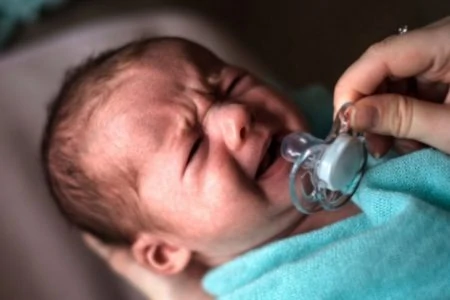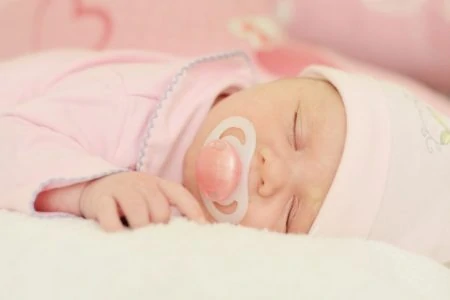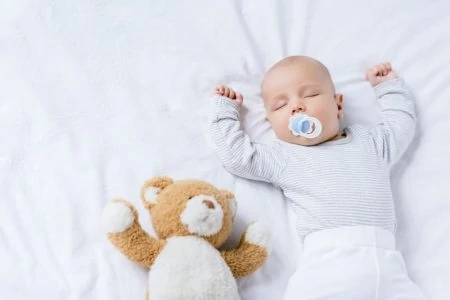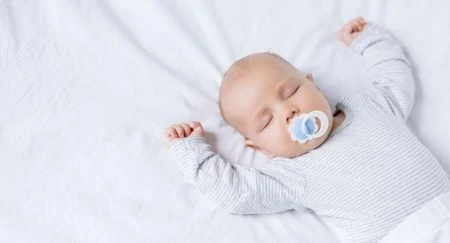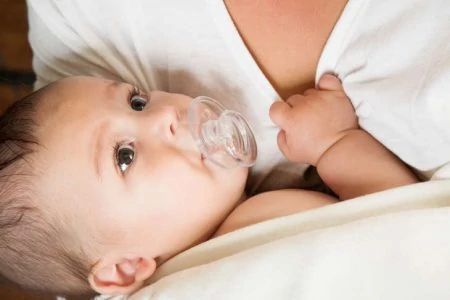Are you wondering if your baby will be safe while using a pacifier?
We live in a day and age where parents and experts are questioning traditional ways of raising children. We now know that some medicines our grandparents used are toxic, and crib comforters turned out to be a pretty bad idea. So, we naturally cast a suspicious eye over everything recommended to us.
Pacifiers, unfortunately, are one of those items that are not very clear-cut.
We’ve studied all the modern research on pacifier usage and discovered some interesting advantages and disadvantages to using them. We created this comprehensive pacifier safety guide, so you can make an informed decision about whether they are right for your child.
Key Takeaways
- Pacifiers can affect the alignment of baby’s teeth and shape of the roof of the mouth when used for extended periods.
- It is recommended to wean baby off pacifiers before they have a full set of baby teeth.
- Always buy pacifiers from established manufacturers and check for size, moving parts, and air vents.
- Choking hazards can occur with pacifiers, so make sure it’s age-appropriate, made of one solid piece of silicone, and has at least two large air vents in the shield.
- Never use a pacifier tie or strap as it can be a serious hazard.
- Will Pacifiers Hurt My Baby’s Teeth?
- Can Babies Choke on Pacifiers?
- Can Pacifiers Cause Nipple Confusion?
- Will My Baby Get an Infection From Using Pacifiers?
- Is It Safe To Put My Baby To Bed With a Pacifier?
- Are There Times when a Pacifier Can Really Help?
- When Should I Start and Stop Using a Pacifier?
- Pacifier Safety FAQs
- The Bottom Line
Will Pacifiers Hurt My Baby’s Teeth?
Pacifiers are not great for teeth. Experts agree on this point, and it’s often parents’ biggest concern about pacifiers. Nevertheless, it appears that more than 80% of babies use them (1).
Because of their shape, when used for an extended time, they cause your baby’s teeth to be gently nudged into a new position, a bit like braces do. There is moderate evidence that they can make the upper teeth splay out and the lower teeth fold in (2). It also appears that they can affect the shape of the roof of the mouth.
There are tooth-friendly bottles, but pacifiers are different. A pacifier stays in the baby’s mouth for longer periods throughout the day, creating constant pressure and impacting the alignment of the teeth.
Even a naturally shaped pacifier is going to have some effect. And buck teeth or a severe overbite are not just cosmetic problems — they can cause delays in proper speech, swallowing issues, problems with eating solids, and even jaw development issues.
Most of these problems do not seem to be an issue when your baby has no teeth or only a few. But to avoid complications, it’s a good idea to wean your baby off a pacifier well before they have their full set of baby teeth.
Can Babies Choke on Pacifiers?
As with anything that goes into a baby’s mouth, there is a real risk of choking that should not be underestimated. Just because a pacifier is made for sucking and is sold in stores does not mean we should automatically trust that it is safe or even good for babies.
Always buy pacifiers from established manufacturers. Some cheap novelty ones or old designs may have loose parts that are choking hazards. When shopping for a pacifier, check the U.S. government’s website for recalls to ensure there are no problems with your brand of choice.
Check your pacifier for size, moving parts, and air vents.
- Size: Your baby’s mouth size will determine the right pacifier size. Always choose an age-appropriate pacifier unless your baby is small because of a medical condition such as dwarfism, intrauterine growth restriction (IUGR), or prematurity. A safe pacifier must be at least 1.5 inches wide (3) so your baby cannot take it fully into the mouth.
- Moving parts: Makes sure to buy a pacifier made of one solid piece of silicone. If there are any moving parts other than the handle, you need to throw it out. Check the integrity of the parts before each use, as sometimes the flexible nipple can crack and parts can loosen with time. Learn how to do the pull test and do it every time.
- Air vents: Federal regulations state that a pacifier must have at least two large air vents in the shield. This will allow a baby to breathe even if the pacifier gets sucked into their mouth (4).
Finally, never use a pacifier tie or strap, as these can be a serious hazard for your baby. They can get caught on a stationary object and wrap around your baby’s neck, causing a risk of strangulation.
Can Pacifiers Cause Nipple Confusion?
When used too early, pacifiers can make your baby reject the breast and even the bottle. A newborn baby might become confused because the size and shape are so different from a natural nipple or bottle nipple.
The way babies latch for nursing can be affected by pacifiers in those early weeks. The latch onto a pacifier tends to be more shallow, and this can cause babies to have difficulty when trying to take enough of the breast in to get a good feeding.
Some pacifiers, like Hevea and NUK soothers, try to imitate the shape and squishiness of a mother’s natural nipple. These can help your baby suck in a manner most closely resembling the natural way.
Pacifiers can also present other feeding challenges. They can help satisfy the sucking need of smaller babies, meaning they don’t notice as quickly when they are hungry and might feed less often. This can also affect a mom’s milk supply.
Pro Tip
The flip side is that some babies use the breast as a pacifier. If your baby is sucking but not swallowing long after the feed is finished, leaving you sore, you might want to use a pacifier then in limited amounts to prevent cracked nipples.
Will My Baby Get an Infection From Using Pacifiers?
Studies have shown that pacifiers carry bacteria and yeast, placing babies at risk for infections. This is because having something touching other objects and then going into the mouth frequently means those organisms may hitch a ride.
Bacteria and other microbes can also breed in tiny pores on pacifiers, especially the longer they are around, so unless you keep a supply and sterilize pacifiers regularly, they’ll carry some bacteria (5). Wash them frequently with hot, soapy water, and let them air dry. Make sure not to lick them clean or share them among siblings. And throw them away after two to four weeks of use.
Most recent studies have shown a clear risk between pacifier use and ear infections in babies between six months to two years old. However, the reason for this is still unclear. Experts believe that sucking on the pacifier changes the pressure gradient between the eustachian tube and the middle ear, creating an environment more conducive to infection. Others have suggested that pacifiers, since they are used more often in babies that have weaned early, may be a marker for babies that are not breastfed and, therefore, are already known to have a greater risk for ear infections (6).
Both the American Academy of Pediatrics and the American Academy of Family Physicians recommend weaning the pacifier before your baby is 6 months old to help prevent ear infections.
Is It Safe To Put My Baby To Bed With a Pacifier?
Pacifiers can be a lifesaver for parents with a restless baby. The act of sucking can help babies get to sleep, but if you keep nursing your baby to sleep, you can create a sleep association that will leave you exhausted.
Pacifiers have also been found to reduce the risk of SIDS. It is assumed this is because the motion of sucking keeps babies’ breathing rate regular.
The big downside to both of these is that pacifiers can create a sleep association, which is basically a habit. This means that you may end up with a baby who cannot fall asleep without the pacifier. You may then have to get up throughout the night to keep replacing it when they awaken. To prevent this, you should wean your baby off the pacifier between 4 and 12 months of age.
Are There Times when a Pacifier Can Really Help?
There are situations where giving a pacifier has been shown to really help babies (7). It gives them periods of Non-Nutritive Sucking (NNS), which benefits babies in certain contexts.
- Studies have shown that giving a pacifier during or just after a painful procedure, like circumcision, heel prick, or vaccination, can comfort babies and help their heart rates return to normal more quickly. Putting expressed breast milk or formula on the nipple creates an even greater effect on pain control and stress relief. You should only do this when the pacifier is used for pain management and never on a regular basis as it contributes to tooth decay.
- There is a benefit to pacifier use when babies have to be separated from their mom for a time. This might happen if an infant becomes ill, for example, and has to be admitted to the hospital. There may be times with procedures or testing where they cannot feed. Pacifiers can give babies a way to cope by using self-soothing NNS and prevent loss of the sucking reflex.
- Premature babies who are developing the coordination for suck-swallow-breathe may need stimulation to move this process along. NNS gives them the chance to practice and establish a healthy pattern while transitioning to oral feeding. This would take place in the NICU environment with the guidance of medical professionals.
When Should I Start and Stop Using a Pacifier?
A healthy breastfed baby should only begin when feedings are well established to decrease the risk of nipple confusion. It is a good idea for bottle-fed babies to wait until they are back to their birth weight (8).
Crucial To Know
Some babies will even wean themselves off their pacifier or start chewing it instead when they begin teething. This could make the transition very easy, so seize the moment, and give them a teething toy instead. Make sure to get rid of all your pacifiers if this happens, so you won’t be tempted to go back.
Pacifier Safety FAQs
The Bottom Line
Pacifiers have some benefits and some downsides, and nobody but you can decide if they’re right for your baby.
Starting a pacifier too soon and ending its use too late may cause problems. Also, how frequently you use it may be a factor in ear infections, teeth issues, sleeping patterns, speech development, self-soothing skills, and the eventual ability to discontinue use.
The SIDS-prevention advantages of pacifier use might mean it’s helpful to use it for sleep only, and only during the first year of life. Beyond that time, the beneficial effects are less, and more of the negative factors begin to weigh in.
With this guide, you can make an informed decision about whether pacifiers may be right for you and your child. It may not have to be an all-or-nothing decision. Noting the times that a pacifier will be helpful is key. Weaning it at the appropriate age and not using it as a crutch will ensure that all goes well for you and your baby.
